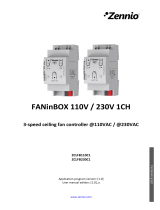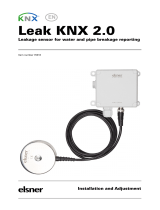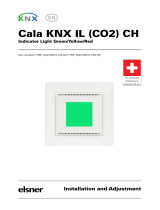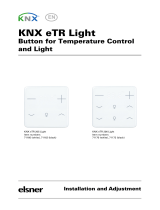Page is loading ...

HeatingBOX
http://www.zennio.com Technical Support: http://support.zennio.com
2
CONTENTS
Contents ................................................................................................................................... 2
Document Updates ................................................................................................................... 3
1 Introduction ...................................................................................................................... 4
1.1 HeatingBOX .................................................................................................................. 4
1.2 Installation ................................................................................................................... 5
1.3 Start-Up and Power Loss .............................................................................................. 6
2 Configuration .................................................................................................................... 7
2.1 General ........................................................................................................................ 7
2.2 Thermostats ................................................................................................................. 9
2.3 Logic Functions ........................................................................................................... 10
2.4 Heating Controls......................................................................................................... 11
2.4.1 Heating Output n ................................................................................................ 15
2.4.1.1 Configuration........................................................................................... 15
2.4.1.2 Alarms ..................................................................................................... 20
2.4.1.3 Cyclical Monitoring .................................................................................. 22
2.4.1.4 Startup .................................................................................................... 24
2.4.1.5 Characteristic Curve ................................................................................. 25
2.5 Manual Control .......................................................................................................... 28
ANNEX I. Communication Objects of HeatingBOX 24V ............................................................. 31
ANNEX II. Communication Objects of HeatingBOX 230V .......................................................... 35

HeatingBOX
http://www.zennio.com Technical Support: http://support.zennio.com
3
DOCUMENT UPDATES
Version
Changes
Page(s)
[1.2]_a
New devices: HeatingBOX 24V 4X / 8X.
Changes in the application programme:
New module: Heartbeat.
New parameters:
o Value for open valve.
o Opening minimum value.
Output lock due to short circuit/overload error.
Optimisation of thermostat and logic functions
modules.
-
Lock due to short circuit/overload error.
15
Heartbeat module.
7
[1.1]_a
Changes in the application programme:
Optimisation of the start-up process.
-

HeatingBOX
http://www.zennio.com Technical Support: http://support.zennio.com
4
1 INTRODUCTION
1.1 HeatingBOX
HeatingBOX from Zennio is a heating-specific KNX actuator equipped, with four or eight
independent outputs for controlling 24V or 230V valves, depending on the device.
The most outstanding features are:
4 or 8 configurable outputs for controlling electromechanical valves.
A sole 230 VAC or 24 VAC/VDC power input for all outputs.
4 or 8 independent thermostats (one per output).
10 customisable, multi-operation logic functions.
Manual operation / supervision of the outputs through the on-board
pushbuttons and LEDs.
Heartbeat or periodical “still-alive” notification.

HeatingBOX
http://www.zennio.com Technical Support: http://support.zennio.com
5
1.2 INSTALLATION
HeatingBOX connects to the KNX bus through the on-board KNX connector.
Once the device is provided with power from the KNX bus, both the individual address
and the associated application programme may be downloaded.
Figure 1. HeatingBOX 230V 8X.
Note: the above element diagram is slightly different for HeatingBOX 230V / 24V 4X,
although entirely analogous.
The main elements of the device are described next.
Test/Prog. Pushbutton (5): a short press on this button sets the device into
the programming mode, making the associated LED (5) light in red.
Note: if this button is held while plugging the device into the KNX bus, the device
will enter into safe mode. In such case, the LED will blink in red every 0.5
seconds.
Phase Inputs (1): slots for the connection of the voltage lines (phase). Both
inputs are internally shorted.
3
2
7
5
4
6
1
1. 24V / 230V power inputs (phase).
2. Valve outputs.
3. Manual control pushbutton.
4. Output status LED.
5. Prog./Test pushbutton.
6. Prog./Test LED.
7. KNX connector.

HeatingBOX
http://www.zennio.com Technical Support: http://support.zennio.com
6
Outputs (2): output ports for the insertion of the stripped cables of the systems
being controlled by the actuator. Please secure the connection by means of the
on-board screws.
Manual control pushbuttons (3): pushbuttons for a direct control of the
outputs during the set-up process. See section 2.5.
To get detailed information about the technical features of this device, as well as on the
installation process and on security procedures, please refer to the corresponding
Datasheet, bundled with the original packaging of the device and also available at
www.zennio.com.
1.3 START-UP AND POWER LOSS
During the start-up of the device and depending on the configuration, some specific
actions may be performed. For example, the integrator can set whether the outputs
should change to a particular position and whether the device should send certain
objects to the bus after the power recovery. Please consult the next sections of this
document for further details.
On the other hand, when a bus power failure takes place, the device will interrupt any
pending actions, and will save its state so it can be recovered once the power supply is
restored.

HeatingBOX
http://www.zennio.com Technical Support: http://support.zennio.com
7
2 CONFIGURATION
After importing the corresponding database in ETS and adding the device into the
topology of the desired project, the configuration process begins by entering the
Parameters tab of the device.
2.1 GENERAL
From the “General” screen it is possible to activate/deactivate all the required
functionality.
ETS PARAMETERISATION
Figure 2. General screen
Heartbeat (Periodic Alive Notification) [disabled/enabled]
1
: incorporates a
one-bit object to the project (“[Heartbeat] Object to Send ‘1’”) that will be sent
periodically with value “1” to notify that the device is still working (still alive).
Figure 3. Heartbeat
1
The default values of each parameter will be highlighted in blue in this document, as follows:
[default/rest of options].

HeatingBOX
http://www.zennio.com Technical Support: http://support.zennio.com
8
Note: the first sending after download or bus failure takes place with a delay of
up to 255 seconds, to prevent bus overload. The following sendings match the
period set.
Thermostats [disabled/enabled]: enables or disables the “Thermostats” tab in
the tree on the left. See section 2.2 for details.
Logic Function [disabled/enabled]: enables or disables the “Logic Functions”
tab, which contains specific parameters for the case the Logic Functions
module is required. See section 2.3 for details.
Heating Controls [enabled]: read-only parameter to make it evident that the
“Heating Controls” tab is always enabled in the tab tree on the left. See section
2.4 for details.
Manual Control [disabled/enabled]: enables or disables the “Manual Control”
tab in the tree on the left. See section 2.5 for details.

HeatingBOX
http://www.zennio.com Technical Support: http://support.zennio.com
9
2.2 THERMOSTATS
HeatingBOX implements four or eight Zennio thermostats, depending on the device
outputs number, which can be enabled and configured independently.
Please refer to the specific “Zennio Thermostat” user manual (available in the
HeatingBOX product section at the Zennio homepage, www.zennio.com) for detailed
information about the functionality and the configuration of the related parameters.

HeatingBOX
http://www.zennio.com Technical Support: http://support.zennio.com
10
2.3 LOGIC FUNCTIONS
This module makes it possible to perform numeric and binary operations to incoming
values received from the KNX bus, and to send the results through other communication
objects specifically enabled for this purpose.
HeatingBOX can implement up to 10 different and independent functions, each of
them entirely customisable and consisting in up to 4 consecutive operations each one.
The execution of each function can depend on a configurable condition, which will be
evaluated every time the function is triggered through specific, parameterisable
communication objects. The result after executing the operations of the function can also
be evaluated according to certain conditions and afterwards sent (or not) to the KNX
bus, which can be done every time the function is executed, periodically or only when
the result differs from the last one.
Please refer to the specific “Logic Functions” user manual (available in the HeatingBOX
product section at the Zennio homepage, www.zennio.com) for detailed information
about the functionality and the configuration of the related parameters.

HeatingBOX
http://www.zennio.com Technical Support: http://support.zennio.com
11
2.4 HEATING CONTROLS
The HeatingBOX actuator incorporates four or eight outputs, each of them capable of
controlling one or several heating valves at 24V or 230V.
The actuator provides a set of common options to configure the general operation of
these valves:
A start-up delay, to prevent performing control orders over the outputs
immediately after the device initialisation. Note that this start-up delay is
interrupted if alarm or lock orders (see section 2.4.1.1) are received.
Short-circuit, overload and all-valves-closed notifications, which are
periodically sent through specific one-bit objects in case such events occur:
Short-circuit or overload: in case a short circuit or overload is detected on
a particular output:
HeatingBOX 24V periodically reports both errors via a single
communication object.
HeatingBOX 230V reports both errors independently. If a short circuit is
detected at an output, it will be periodically notified through a specific
object of that output, while overload error is reported jointly for outputs 1-
4 and 5-8, through an object per group.
In the event of any of the two errors, the current flow through the
corresponding output or group of outputs will be interrupted (the valve will
return to idle position) and the associated LED or LEDs will flash every
second. This status will be maintained until a new control order is received.
If 4 errors are detected in a 3 minutes period on any of the channels, the
device will lock all regulation for the next 3 minutes and the programming
LED will flash together with all the output LEDs. There will also be a status
object to notify the activation and deactivation of the lock.
All valves closed: it may be significant for the climate system whether all
valves are currently closed or not (e.g., to switch off the climate unit in case
they are). This notification can be restricted for a specific set of valves (so

HeatingBOX
http://www.zennio.com Technical Support: http://support.zennio.com
12
the state of the other valves is not taken into account) and also delayed, to
ensure that such situation is not transitory and persists in time.
Maximum control value object, which reports (with a configurable periodicity)
the maximum of the current control values of the outputs that may have been
marked for such purpose. An external value (i.e., received through a specific
object) can be also considered for this comparison, which brings the option to
link multiple actuators together and to determine the maximum of all of them.
The optional anti-seize protection function, which automatically switches the
state of those outputs that have been in the same position for more than a
configurable time. After a certain duration (also configurable), they return to
their previous state.
ETS PARAMETERISATION
Figure 4. Heating Controls – Configuration (HeatingBOX 8X).
From the “Configuration” screen is possible to enable/disable all the common functions
required. In addition, each output can be individually enabled.
Startup Delay [0…255][s]: delay after the device initialisation.
Short Circuit/Overload Error Notification [disabled/enabled]: when enabled,
the following one-bit objects will be available:

HeatingBOX
http://www.zennio.com Technical Support: http://support.zennio.com
13
HeatingBOX 24V: “[HCx] Short Circuit/Overload Error”, one for each
output.
HeatingBOX 230V: “[HCx] Short Circuit Error”, one for each output, and
“[HCx-y] Overload Error” one for outputs 1-4 and one for outputs 5-8; the
latter only in HeatingBOX 230V 8X.
These objects will be sent to the bus with the value ‘1’ every 30 seconds as
long as the error persists, and with the value ‘0’ (once) when the error is
over.
In addition, for both devices, the object “[CC] Short Circuit/Overload Lock”,
common to all output, will be enabled. This object will be sent with value “1”
when at least 4 error events have been detected in a period of 3 minutes in any
of the channels. Three minutes after its activation, the value “0” will be sent,
leaving the locking deactivated.
Notify When All Valves Are Closed [disabled/enabled]: if enabled, it provides
the one-bit object “[HC] All Valves are Closed”, which will be sent to the bus
with a configurable value, depending on whether are valves are found to be
closed or not. A delay can be parameterised to ensure the persistence of this
situation.
Note: this function ignores those outputs that have not been specifically
marked for this purpose (see section 2.4.1).
Figure 5. Notify when all valves are closed.
Value [Send 0 / Send 1].
Delay [0…30…1440][min] [0…24][h].
Note: this delay must be greater than the cycle time (either in case of making
use of an external device or of the 1-byte control method). See section 2.4.1.

HeatingBOX
http://www.zennio.com Technical Support: http://support.zennio.com
14
Maximum Control Value [disabled/enabled]: enables the 1-byte object “[HC]
Max. Control Value (Output)”, which reports the maximum of the control
values of the outputs marked for this purpose (see section 2.4.1).
Figure 6. Maximum control value.
Include External Value [disabled/enabled]: enables the 1-byte object “[HC]
Max. Control Value (Input)” for the reception of an additional value which
will be taken into account to determine the above maximum.
Resending Period [0…30…255][min].
Note: this function ignores those outputs that have not been specifically
marked for this purpose (see section 2.4.1).
Anti-Seize Protection [disabled/enabled]: enables or disables the anti-seize
protection function. The “[HCx] Anti-Seize Protection” binary object will send
the value “1” when the anti-seize process is triggered for output “x”, and the
value “0” when it is over.
Figure 7. Heating Controls – Anti-Seize Protection.
Periodicity [1…7…30][day]: sets the maximum time an output can remain
still.
Duration [1…5…255][min]: sets for how much time the output should switch
its position, in case it has been still for more than the above periodicity.

HeatingBOX
http://www.zennio.com Technical Support: http://support.zennio.com
15
Output n [disabled/enabled]: enables or disables output number “n”. A specific
set of pages is added to the tab tree on the left per enabled output. Please see
section 2.4.1.
2.4.1 HEATING OUTPUT n
Each output enabled provides a Configuration screen with a set of general parameters,
as well as some more screens with optional settings.
2.4.1.1 CONFIGURATION
The general configuration of each output entails the following options:
Control method: sets the type (binary or percentage) of the object that will
receive the control orders for the output. These commands must be received
from a thermostat (either internal or external), so the object type must match
the control type performed by the thermostat.
Important: percentage values are internally transformed into a PWM signal
(which is what the actuator actually applies to the output), the period of which
must be defined by the integrator, while under a one-bit control such period is
assumed to be already defined in the thermostat. In both cases, to ensure a
proper behaviour, it is important that the PWM period is not lower than the valve
transition time (opening or closing).
In order to avoid pressure problems in the valves caused by negligible
regulations, if the selected control method is percentage, a minimum opening
value must be set. Thus, any output command between and the
parameterized value, will follow the following logic:
If the valve is open, the output value will be parameterized.
If the valve is closed, it will remain closed.
Value for Open Value: sets which value will command the valve to open.
Valve type: sets the type of the valve connected to the output, which may be
normally open (in the absence of power, the valve remains open) or normally
closed (in the absence of power, the valve remains closed).

HeatingBOX
http://www.zennio.com Technical Support: http://support.zennio.com
16
The format of the control orders is independent of the valve type. The range of
the binary or parentage objects (depending on the control method) remains the
same in any case – the actuator internally decides whether to apply power or not
to the valve depending on the order received and the valve type.
The following table summarises the device behaviour according to the valve type
and the control order received. Note that the status LED of each output indicates
whether current is supplied to the output or not and not whether the valve is open
or closed (it depends on the valve type).
Valve type
Value for
Open Valve
Control order
Output power
LED
Valve state
1 bit
1 byte
Normally
closed
1
1
100%
Yes
Open
0
0%
No
Closed
0
0
100%
Yes
Open
1
0%
No
Closed
Normally
open
1
1
100%
No
Open
0
0%
Yes
Closed
0
0
100%
No
Open
1
0%
Yes
Closed
Table 1 Device behaviour according to the valve type.
Whether the output (valve) should be considered or not for the notification in
case all valves are closed or to calculate the maximum control value (see
section 2.4).
Activation and deactivation of the status objects of the one-bit and one-byte
control values.
Lock function, which provides a one-bit object to temporarily deactivate the
control of the output (valve), being possible to leave it as is until it gets
unlocked, or to switch it to a particular position.
Alarms: see section 2.4.1.2.
Cyclical monitoring: see section 2.4.1.3.

HeatingBOX
http://www.zennio.com Technical Support: http://support.zennio.com
17
Characteristic curve: see section 2.4.1.5.
Start-up type: see section 2.4.1.4.
ETS PARAMETERISATION
The “Configuration” screen of each individual heating output contains the following
parameters:
Figure 8. Heating Control – Configuration.
Control method:
[1 bit]: the orders to close (value “0”) and to open (value “1”) the valve must
be received through the one-bit object “[HCx] Control Value – 1 bit”.
[1 byte]: the orders to close (value “0%”) and to open (value “100%”) the
valve must be received through the one-byte object “[HCx] Control Value
– 1 byte”. This method entails the following parameters as well:
PWM Period [5…3600][s] [1…15…1440][min]: sets the PWM cycle time,
i.e., the base time for the PWM modulation.
The device will perform opening and closing orders to the valve
alternatively in order to satisfy the control value.

HeatingBOX
http://www.zennio.com Technical Support: http://support.zennio.com
18
Example: if the cycle time is 10 minutes and a control value of 20% is
received, then (every ten minutes):
The valve will remain open for 2 minutes.
Afterwards it will remain closed for 8 minutes.
Opening Minimum Value [0…100][%]: minimum value from which the
output will start to regulate.
Note: Even if the control orders come from an alarm, lock, etc., the
minimum value criterion will also be applied, so it is recommended not
to set fixed regulation values below the minimum in these functionalities.
Example: assuming an opening minimum value of 20%, the final
status of the valve at the following control orders will be as follows:
Valve = 0% control order = 10% Valve = 0%.
Valve = 30% control order = 10% Valve = 20%.
Valve = 0% alarm with action = 15% Valve = 0%.
Valve = 50% alarm with action = 15% Valve = 20%
Value for Open Valve [1 / 0]: sets the control value to open the valve. The
polarity will also affect the status object of both control methods (1 bit and 1
byte).
Valve type [Normally Closed / Normally Open].
Note: the control value to close a valve is “0” or “1” (under a one-bit control),
as the previous parameter is configured, or always “0%” (under a 1-byte
control) no matter if the valve is normally open or normally closed. See Table
1 for details.
Count with this output to:
Notify That All Valves Are Closed [disabled/enabled]: when checked, the
current output will be taken into account to determine whether all valves are
closed or not.

HeatingBOX
http://www.zennio.com Technical Support: http://support.zennio.com
19
Note: this option is only available if the Notify When All Valves Are Closed
function has been enabled (see section 2.3).
Calculate the Max. Control Value [disabled/enabled]: when checked, the
current output will be taken into account to calculate the maximum control
value amongst all the outputs.
Note: this option is only available under a one-byte control and when the
Maximum Control Value function has been enabled (see section 2.3).
Show Status Objects [disabled/enabled]: adds one or two (depending on the
control type) status objects to the project in relation to the control value.
“[HCx] Control Value – 1 bit (Status)” (available in both, the one-bit and
the one-byte controls): it will send the value “0” when the output closes and
the value “1” when it opens.
“[HCx] Control Value – 1 byte (Status)” (only for the one-byte control): it
will send the current control value whenever it changes.
Note: this object corresponds to the input value of the characteristic curve
(value in the X axis), not to the output value. See section 2.4.1.5
Lock [disabled/enabled]: provides the “[HCx] Lock” one-bit object, which
permits locking (with the value “1”) or unlocking (with the value “0”) the control
of the output. While locked, the output ignores any control commands.
When this function has been enabled, the following parameter appears:
Action: sets an action to be performed by the output when it gets locked.
One-bit control [No Change / Close Valve / Open Valve].
One-byte control [No Change / Specific Control Value]. When selecting
the latter, the parameter Control Value [0…100] lets introducing the
desired percentage value.
Alarms [disabled/enabled]: enables or disables the Alarm function. See section
2.4.1.2.

HeatingBOX
http://www.zennio.com Technical Support: http://support.zennio.com
20
Cyclical Monitoring of the Control Value [disabled/enabled]: enables or
disables the Cyclical Monitoring function. See section 2.4.1.3.
Characteristic Curve [disabled/enabled]: enables or disables the
Characteristic Curve function. See section 2.4.1.5.
Startup [Default / Custom]: sets whether, during the device initialisation, the
output should behave normally or perform a custom action. See section 2.4.1.4.
2.4.1.2 ALARMS
The Alarms function allows changing the state of the output on the reception of an alarm
trigger from the KNX bus. It is possible to configure the state the output will be switched
to, both on the alarm activation and on the alarm deactivation.
Cyclically monitoring the alarm trigger is also possible by defining a certain time period.
The actuator will check that the alarm or no-alarm state is received at least once before
the period expires (note: this check doesn’t take place unless the object has been
received at least once). In case the object stops being refreshed (i.e., the actuator does
not receive an updated value anymore), the alarm action will be performed as well, for
safety reasons.
Regarding the deactivation of the alarm, it is also possible to configure a simple
deactivation or an acknowledgement-demanding deactivation.
The first case triggers the deactivation action as soon as the alarm object
recovers its normal value.
The second one, on the other hand, requires that an external
acknowledgement (through another object) is received after the alarm object
has recovered its normal value.
Notes:
Alarms always prevail over other functions (e.g.: lock orders during the alarm
state will be ignored; alarm orders during the lock state will not).
Alarm has priority over Alarm 2. If a channel is in alarm 2 and alarm 1 is
activated, the alarm 1 action will be executed until the alarm 1 is deactivated,
resuming the alarm 2 status (but without executing the alarm 2 action again).
/














